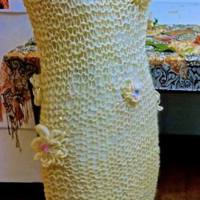Heidi, one of our readers, has asked for a recipe using lenga-lenga (amaranth). Here are some recipes, together with information on lenga-lenga – its use, cultivation and value as a key indigenous food.
The crop:
Lenga-lenga is one of a hand-full of basic, inexpensive, easy-to-cultivate, and nutritious crops in Burundi and surrounding areas. Its use transcends both ethnic and economic categories – a useful feat in an area typified by economic divides as well as decades of ethnically based strife.
As a crop, lenga-lenga is easy to plant and care for, and matures in only three weeks.

Lenga-lenga is often grown along roads and in spare plots – this is by the fence of the airport. The mound of sand is where a hand-dug well has been developed in order to water the crop.

- Lenga-lenga plots can be easily cared for by one woman – who plants, cultivates, harvests, bundles and sells the crop.

Harvested lenga-lenga is immediately tied into small bundles, which can be seen at the bottom of the photo.

In large plots, the entire family may help in the harvest, together with friends or relatives. The bundles of lenga-lenga are being placed under plastic sheets where they will remain until early the next morning, when they will be taken to local markets or into city markets very early.

Women holding a stock of arid-lands lenga-lenga in eastern Burundi – more information on following picture.

The arid land lenga-lenga self-seeds and is generally not cared for, but harvested from these wild stands. I’m not aware of any work being done to document the various types of lenga-lenga but it is a task that needs to be done, as we move into changing climatic conditions.
Recipes for Lenga-Lenga:
There are no ‘fixed’ recipes for lenga-lenga, everyone has their favorite way of making it. However, basic ingredients are the same:
- Lenga-lenga leaves and small parts of the stems
- palm-oil
- tomatoes
- onion
- pili-pili – hot sauce made of red peppers
There are other items that could be added, such as:
- Meat pieces (usually goat)
- Small fish
- Garlic
- Green peppers
- Red beans
The ingredients and the amounts are really up to you! Though the steps are similar – first, heat oil and saute onions, (garlic; green peppers) then add tomatoes and simmer, followed by meat pieces (pre-cooked) or small fish or beans.

Wash and pick off leaves from the stems together with tender stem pieces.

To keep cleaned lenga-lenga fresh, place in a bowl with water.

Lenga-lenga sauce wtih palm oil, onion and tomatoes being cooked in front while thick porridge of manioc flour with which to eat the sauce is being made in back.

Prepared for the Hotel Club du Lac Tanganyika, and served with thick porridge cassava balls by Chef Richard.

A ‘westernised’ lenga-lenga based dish that I make from time to time, with olive oil, lots of garlic, tomatoes, onions, potatoes – all cooked in a rich meat sauce.

For a Sunday meal, eating lenga-lenga with mukeke fish from Lake Tanganyika that has been grilled over charcoal is delicious.
The following blog gives a recipe using lenga-lenga and INUPU – an indigenous potato that grows here in the highlands:


























Hi would love to have some Lenga seeds from Burundi to plant in my garden, would it be possible to purchase some seed?
LikeLike
Pingback: Callaloo (and a recipe, too!) | Adventures in Congo
Pingback: Republic of Burundi «
These greens sound delicious… I’d love to put a few rows on my garden… Can you email me any leads on seeds?
Thank you!
Juan
LikeLike
Juan – many folks have asked me the same question – unfortunately, there are no commercial seeds, seed plants are maintained and then used by the farmers. The seeds are so small, that they are mixed with sand in order to seed a fresh bedding.
LikeLike
I have bought Amaranth seed from Kitazawa seed co. They specialize in varities not commonly found in American gardens.
LikeLike
Good for you, and hope that you enjoy it!
LikeLike
OMG!!! The Kitazawa Seed Co. is just a few miles from me…
AMAZING
Thank You so much…
LikeLike
Good for you!! Enjoy!!
LikeLike
These greens sound delicious… I’d love to put a few rows on my garden… Can you email me any leads on seeds?
Thank you!
LikeLike
Thank you SOOOOOOOOOO much!!! I have some seeds that my MIL sent back with me last summer. I’m planning to plant them this spring so we can make lots and lots of yummy lenga-lenga now! 🙂
Thanks again!!!
~Heidi
LikeLike
That is great, and I’m sure that you’ll enjoy them. Really, tastier than spinach and just as nutritious!
LikeLike
Big up! from RAHA ZA PWANI BLOG http://www.saidpowa.blogspot in Tanzania. Nomally is in Swahili but some times English is there, so your welcome to visit it for news from Tanzania.
LikeLike
Hello Said – thanks! The link to your blog isn’t working… corrections? Always happy to hear news from Tanzania, when living and working in Kenya I had the opportunity to visit several times, to Arusha area and also Dar. Lovely country!
Looking forward to getting your blog link!
LikeLike
ok – got it, address from a web search. Thank! Will follow!
LikeLike
Pingback: Nibbles: Vegetables, UK funding, Oz funding, Oz genebank, Jefferson, Hawaiian food, Markets, Tree seeds, NUS journal, Geographic targeting, ITPGRFA, Arabica and climate, Protected areas, European farmland biodiversity, Sustainable use, Ethiopian seed vide
Pingback: Nibbles: Vegetables, UK funding, Oz funding, Oz genebank, Jefferson, Hawaiian food, Markets, Tree seeds, NUS journal, Geographic targeting, ITPGRFA, Arabica and climate, Protected areas, European farmland biodiversity, Sustainable use, Ethiopian seed vide
Pingback: Nibbles: Vegetables, UK funding, Oz funding, Oz genebank, Jefferson, Hawaiian food, Markets, Tree seeds, NUS journal, Geographic targeting, ITPGRFA, Arabica and climate, Protected areas, European farmland biodiversity, Sustainable use, Ethiopian seed vide
Pingback: Nibbles: Vegetables, UK funding, Oz funding, Oz genebank, Jefferson, Hawaiian food, Markets, Tree seeds, NUS journal, Geographic targeting, ITPGRFA, Arabica and climate, Protected areas, European farmland biodiversity, Sustainable use, Ethiopian seed vide
Makes me hungry! I loved to know how it taste makes a beautiful ground cover too.
LikeLike
Very nice, soft taste – not bitter like spinach can be. Nutty, in fact. Much nicer than spinach – and equally nutritious.
LikeLike
Pingback: INUMPU – Burundi’s Indigenous Potatoes and A Recipe | DIANABUJA'S BLOG